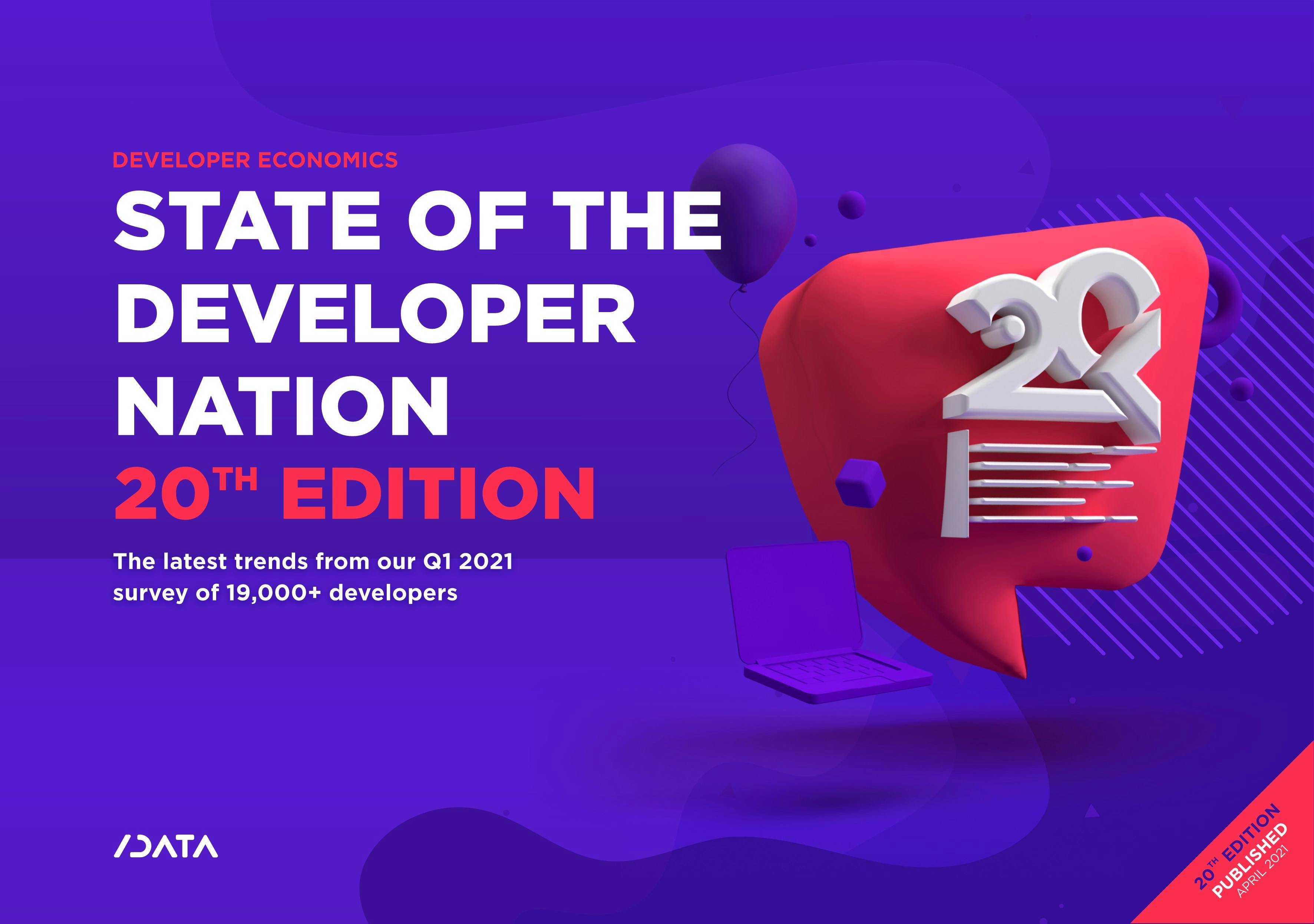
April 10, 2021
State of the Developer Nation 20th Edition - Q1 2021
SlashData Developer Economics is the leading research programme on mobile, desktop, industrial IoT, consumer electronics, embedded, third party app ecosystems, cloud, web, game, AR/VR and machine learning developers, as well as data scientists, tracking the developer experience across platforms, revenues, apps, languages, tools, APIs, segments, and regions.
The 20th Developer Economics global survey wave ran from November 2020 to February 2021 and reached more than 19,000 developers in 155 countries. This research report delves into key developer trends for Q1 2021 and beyond.
The report focuses on six major themes - each with its own visualisations - showing how the data lends insight into the developer community.
- Language communities - an update: Programming languages are often the kernels of strong communities and the subject of opinionated debate. In this chapter, we provide updated estimates of the number of active software developers using each of the major programming languages, across the globe and across all kinds of programmers.
- Machine learning developers and their data: The data science (DS), machine learning (ML), and artificial intelligence (AI) field is adapting and expanding. From the ubiquity of data science in driving business insights to AI’s facial recognition and autonomous vehicles, data is fast becoming the currency of this century. This chapter focuses on this data and the profile of the developers who work with it.
- On the influence of developers: Developers are highly valued for their technical expertise, and are thus often considered to be key influencers when it comes to making technology decisions in companies. In this chapter, we show just how far their influence reaches and what factors leverage their power.
- Emerging technologies: As interest in a technology waxes and wanes, so does its influence. The hot topic of yesterday becomes insignificant in the face of new challenges and opportunities. In our surveys, we have tracked engagement with and adoption of emerging technologies for the past three years. In this chapter, we discuss which technologies have increased and decreased in popularity over the previous 12 months.
- On COVID-19’s current and lasting effects: The COVID-19 pandemic has fundamentally changed the way we work and learn. In this chapter, we provide insights into the extent to which developers shifted to remote working and learning during the pandemic. We also explore the distinct developer groups and regional communities that were affected the most by COVID-19.
- Embedded software - An overview: Embedded software offers many advantages in specific use cases - particularly where performance and power consumption are concerned. However, this type of development brings its own challenges, notably around ensuring maximum stability and security. For the first time in our global survey, we asked developers specifically about their experience in embedded software development. In this chapter, we offer a sneak preview of some of the data we collected.
Methodology
Developer Economics 20th edition reached 19,000+ respondents from 155 countries around the world. As such, the Developer Economics series continues to be the most global independent research on mobile, desktop, industrial IoT, consumer electronics, embedded, third party app ecosystems, cloud, web, game, AR/VR, and machine learning developers and data scientists combined, ever conducted. The report is based on a large-scale online developer survey designed, produced, and carried out by SlashData over a period of ten weeks between November 2020 and February 2021.
Respondents to the online survey came from 155 countries, including major app and machine learning development hotspots such as the US, China, India, Israel, the UK, and Russia and stretching all the way to Kenya, Brazil, and Jordan. The geographic reach of this survey is truly reflective of the global scale of the developer economy. The online survey was translated into eight languages in addition to English - simplified Chinese, traditional Chinese, Spanish, Portuguese, Vietnamese, Russian, Japanese, and Korean - and promoted by more than 60 leading community and media partners within the software development industry.
Our respondents came from a broad age spectrum, from young coders who are under 18 to the seasoned ones over 55. As software development is still a man’s world, 79% of our respondents were male and 20% female, excluding other options and those who did not specify their gender, excluding other options and those who did not specify their gender. Respondents were asked which types of projects they are involved in out of the 13 under study, namely web apps / SaaS, mobile apps, desktop apps, backend services, augmented reality, virtual reality, games, data science, machine learning / artificial intelligence, industrial IoT, consumer electronics devices, embedded software, and apps/extensions for third party ecosystems. They also told us if they are into their areas of involvement as professionals, hobbyists, or students - or as any combination of these - and how many years of experience they have in each.
To eliminate the effect of regional sampling biases, we weighted the regional distribution across eight regions by a factor that was determined by the regional distribution and growth trends identified in our Developer Economy research. Each of the separate branches: mobile, desktop, industrial IoT, consumer electronics, embedded software, third party app ecosystems, cloud, web, games, augmented and virtual reality, and data science and machine learning were weighted independently and then combined.
To minimise other important sampling biases across our outreach channels, we weighted the responses to derive a representative distribution for technologies used and developer segments. Using ensemble modeling methods, we derived a weighted distribution based on data from independent, representative channels, excluding the channels of our research partners to eliminate sampling bias due to respondents who were recruited via these channels. Again, this was performed separately for each of mobile, industrial IoT, consumer electronics, embedded software, third party app ecosystems, desktop, cloud, web, games, augmented and virtual reality, and data science and machine learning.
For more information on our methodology please visit https://www.slashdata.co/methodology.
Contact us
Swan Buildings (1st floor)20 Swan StreetManchester, M4 5JW+441612400603community@developernation.net